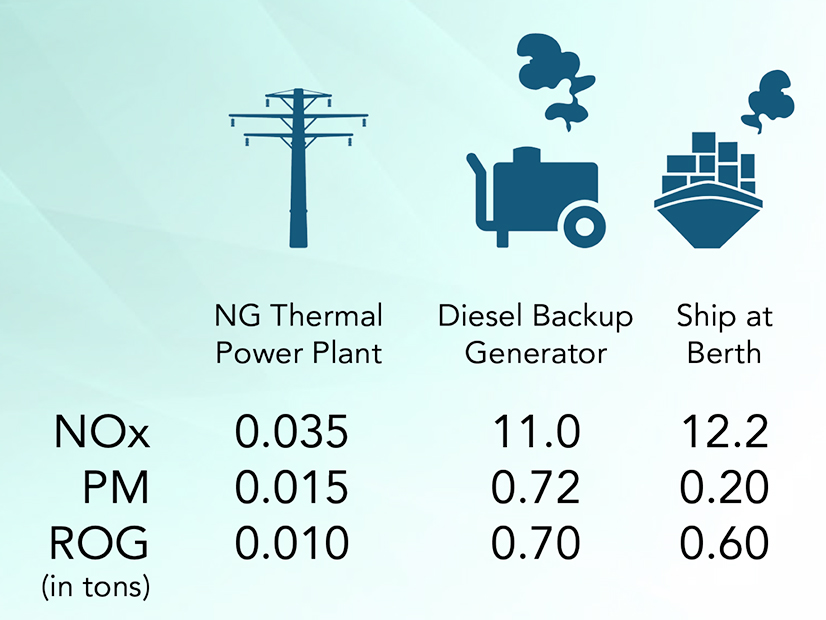California air quality regulators are devising a program to mitigate increased emissions that may occur when the state tries to meet energy demand during heat waves or wildfires.
The California Air Resources Board (CARB) hosted a workshop Thursday evening to discuss the initiative, called the Climate Heat Impact Response Program (CHIRP). The goal is to send a framework for the program to the CARB board for review in November.
CHIRP is the result of an emergency proclamation that Gov. Gavin Newsom issued on July 30, aimed at preventing blackouts during extreme weather in California. (See Calif. Governor Proclaims Emergency as Blackouts Loom.)
The proclamation relaxes certain air quality requirements to allow increased energy production during heat waves — when energy demand surges — or when wildfires disrupt energy transmission.
In California, Senate Bill 100 of 2018 set a target of 100% carbon-free electricity by 2045, and the state is making progress toward that goal.
But “there is insufficient time or supply to install new energy storage or zero-carbon energy projects to address the immediate shortfall of up to 3,500 MW during extreme weather events that is now projected for this summer,” the proclamation said.
California has not had an extreme heat event since the proclamation was issued, according to CARB staff. But the U.S. Department of Energy last week approved CAISO’s request for an emergency order allowing it to run natural gas plants that may exceed federal pollution limits as California heads into peak wildfire season and the ISO seeks to maintain grid stability over the next two months. (See DOE Orders CAISO Emergency Reliability Measures.)
Relaxed Requirements
The governor’s proclamation loosens permitting requirements for backup generators during heat waves, CARB staff said during Thursday’s workshop. Thermal power plants regulated by the California Energy Commission may operate outside of their permitted requirements during the weather events.
And ships at berth may be allowed to use their auxiliary engines, rather than plugging into shore power when at the port.
The restrictions are relaxed when CAISO declares an energy warning or emergency caused by an extreme heat event, a sudden and severe reduction in transmission capacity, or both.
The different methods of meeting energy demand produce varying levels of pollution.
According to CARB estimates, a natural gas thermal power plant produces less than 1% of the nitrogen oxide emissions produced by a backup diesel generator or a ship at berth. A diesel backup generator had the highest emissions of particulate matter among the three sources.
“We know that there are going to be emissions that happen during these [extreme heat] events,” said Michelle Buffington from CARB’s Mobile Source Control Division. “No matter what sources are put online during one of these events, we want to be able to, at least after the fact, mitigate the emissions that have occurred.”
Kevin Hamilton, co-director of the Central California Asthma Collaborative, suggested that the state give residents an early warning when air pollution in their community is expected to spike because of an extreme heat event.
Safe spaces can be created within homes where residents can breathe clean air, he said.
Other workshop participants expressed concern that CARB was taking a reactive approach to the extreme heat events.
Los Angeles resident Rafael Yanez said allowing ships at the ports of Los Angeles and Long Beach to use auxiliary power is “the worst plan that we could possibly have.” He noted that the ships are a major source of air pollution in Southern California.
Instead, Yanez said, the state should look at reducing power consumption among the biggest users. Electric rail service in Southern California could be cut back, as many cars are running with few passengers, he said.
And the fastest way to improve the electric system would be to upgrade aging transmission lines to reduce power losses, Yanez said.
“Look at the transmission lines because many of them are very, very old.”
Reporting Mandates
In addition to a mitigation strategy, CHIRP includes a reporting component.
Utilities must report to CARB each month on the amount of backup generation their customers plan to use during load-reduction periods, as well as an estimated load reduction by zip code for participating customers.
Thermal power plants must report operations above their permitted conditions to CARB, the CEC and air districts.
CARB will work with the CEC and air districts to calculate emissions produced from extra energy generation during extreme heat events. Funding for mitigation projects will be based on the amount of emissions and their location.
CARB staff asked anyone who would like to submit comments on the CHIRP framework to do so by Sept. 30. The program may be contacted at chirp@arb.ca.gov.



